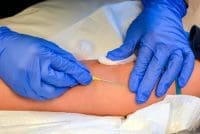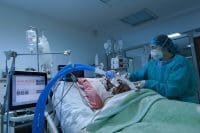Diabetes complications and costs decline when nurses direct care
Putting a nurse in charge of diabetic patients’ care dramatically decreases their need for urgent and emergency care, a new study in Diabetes Care shows. Researchers developed a program in which a specially trained registered nurse provided care to 331 diabetics for 1 year based on detailed treatment guidelines.
- When the program started, just 28% of patients met American Diabetes Association guidelines for long-term blood glucose control and 37% met cholesterol guidelines. After 1 year of the program, 64% met glucose control guidelines and 80% met cholesterol guidelines.
- In the year before the program, the patients made a total of 94 preventable emergency room or urgent visits.
- Charges for diabetes-related urgent or emergency care were $129,176 for the year before the program, compared to $24,630 for the program year. (These figures reflect total charges for urgent care or emergency department visits and hospitalizations only—not other charges related to diabetes care.)
Researchers believe the program succeeded in part because patients learned self-management skills by working with the nurse. They urge policy makers seeking to improve diabetes care and conserve resources to consider adopting this approach.
http://care.diabetesjournals.org/cgi/content/abstract/30/2/224
New stroke prevention guidelines recommend daily low-dose aspirin for nearly all women
In its updated guidelines for cardiovascular disease prevention in women, the American Heart Association (AHA) recommends that routine low-dose aspirin be considered for women of all ages to prevent strokes. The new guidelines suggest women younger than age 65 who are healthy or at moderate risk take aspirin 81 mg daily or 100 mg every other day, unless the risk for hemorrhagic stroke or GI bleeding outweighs the benefit of ischemic stroke prevention. To prevent both myocardial infarction and stroke in women older than age 65 with acceptable blood pressure, AHA offers the same advice.
The guidelines also urge clinicians to weigh other factors (including lifestyle and medical and family histories) besides the Framingham global risk score when making decisions about women’s preventive therapy. Also, hormone replacement therapy, antioxidant supplements, and folic acid are no longer recommended to prevent cardiovascular disease.
http://circ.ahajournals.org/cgi/reprint/CIRCULATIONAHA.107.181546v1
Measuring stroke risk after a TIA
A Lancet study of almost 5,000 patients validates the ABCD2 score as an index of short-term stroke risk after a transient ischemic attack (TIA). To determine this score, the clinician assigns points to the status of the patient’s ABCDs—age, blood pressure, clinical signs, duration, and diabetes. When calculated within 7 days of a TIA, the score identifies patients at high, moderate, or low risk for stroke in the next 2 days, helping clinicians make more rational decisions about whether to admit the patient or provide other urgent interventions or evaluations to prevent stroke.
www.thelancet.com/journals/lancet/full?volume=369&issue=95585
MRI beats CT in detecting acute stroke
In another study published in Lancet, National Institutes of Health researchers found that magnetic resonance imaging (MRI) is better than computed tomography (CT) in detecting acute stroke. Studying a sample of 356 patients who underwent both procedures, they found MRI was accurate 89% of the time, compared to 54% with CT performed on the same patients. Among patients presenting within 3 hours of onset of stroke symptoms, MRI successfully detected 46% of the cases, whereas CT detected only 7%. The investigators advocate MRI as “the preferred test for accurate diagnosis of patients with suspected acute stroke.”
www.thelancet.com/journals/lancet/issue?volume=369&issue=9558
CDC releases updated childhood immunization schedule
Updated childhood and adolescent immunization schedules from the CDC protect pediatric patients against more diseases than ever. The new schedules, released jointly by the CDC, American Academy of Pediatrics, and American Academy of Family Physicians, include new immunization recommendations for rotavirus, human papillomavirus (HPV), varicella, and influenza. Also, for the first time, two separate schedules are provided—one for children ages 0 to 6 years and the other for those ages 7 to 18 years. Additional changes include:
- a three-dose schedule of the new rotavirus vaccine at 2, 4, and 6 months
- influenza vaccine for all children between ages 6 months and 59 months
- a second dose of varicella vaccine given between ages 4 and 6 years
- routine vaccination with the new HPV vaccine for all girls ages 11 to 12 on a three-dose schedule.
“These new schedules reflect the great strides we are making to protect children and adolescents against serious diseases, including cancer,” stated Anne Schuchat, director of the CDC’s National Center for Immunization and Respiratory Diseases.
www.cdc.gov/mmwr/preview/mmwrhtml/mm5551a7.htm
FDA warns that asthma drug Xolair can cause delayed anaphylaxis
The Food and Drug Administration (FDA) has received new reports of delayed-onset anaphylactic reactions to the asthma drug Xolair (omalizumab). Although anaphylaxis usually arises within 2 hours of administration, the new reports involve patients who experienced anaphylaxis up to 24 hours—or even longer—after receiving Xolair. FDA advises healthcare providers to observe patients for at least 2 hours after Xolair administration and to be prepared to manage anaphylaxis. It also urges providers to inform patients about signs and symptoms of anaphylaxis, their chance of developing delayed anaphylaxis, and how to treat it if it occurs. FDA has requested that the manufacturer add a boxed warning to the drug’s label and provide a medication guide for patients.
www.fda.gov/cder/drug/infopage/omalizumab/default.htm
More women needed for breast cancer Sister Study
The National Institute of Environmental Health Sciences (NIEHS) is seeking 19,000 more women to join its Sister Study—The nation’s largest research effort to learn how environment and genes influence breast cancer risk. By the end of 2007, NIEHS must reach its goal of enrolling 50,000 women whose sisters had breast cancer. In the 10-year observational study, participants are asked to answer questions about diet, jobs, hobbies, and exposures and to provide small samples of blood, urine, toenail clippings, and house dust to give researchers a better picture of their environment and genes. Women in the United States and Puerto Rico between ages 35 and 74 may be eligible if their sisters (related by blood, living or deceased) had breast cancer but they haven’t had it themselves. For more information on eligibility, visit the website shown below or call the toll-free number 1-877-4-SISTER (1-877-474-7837).
www.sisterstudy.org/English/index1.htm


















